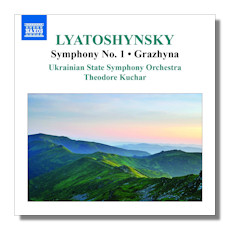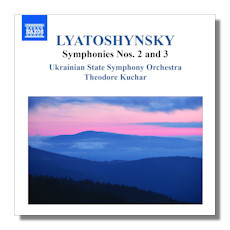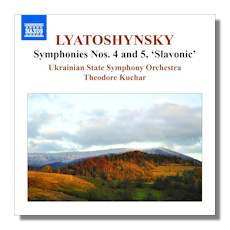
The Internet's Premier Classical Music Source
Related Links
- Latest Reviews
- More Reviews
-
By Composer
-
Collections
DVD & Blu-ray
Books
Concert Reviews
Articles/Interviews
Software
Audio
Search Amazon
Recommended Links
Site News
 CD Review
CD Review
Boris Lyatoshynsky

Symphonies
- Symphony #1 in A Major, Op. 2
- Symphonic Ballad "Grażyna", Op. 58
Ukrainian State Symphony Orchestra/Theodore Kuchar
Naxos 8.555578 56:50


- Symphony #2 Op. 26
- Symphony #3 in B minor, Op. 50
Ukrainian State Symphony Orchestra/Theodore Kuchar
Naxos 8.555579 76:47


- Symphony #4 in B Flat minor, Op. 63
- Symphony #5 in C Major "Slavonic", Op. 67
Ukrainian State Symphony Orchestra/Theodore Kuchar
Naxos 8.555580 55:23
Boris Lyatoshynsky (1895-1968) was one of the most highly regarded and influential Ukrainian composers of the 20th century. He earned the adulation of many Ukrainians, coming to be widely revered as the father of 20th-century Ukrainian classical music. At the heart of his output are his five symphonies which Naxos has now reissued on these three CDs, in what can be described as arguably definitive performances. I hesitate to use the word "definitive" because it suggests too absolute a judgment on an opinionative issue, but in this case it certainly fits: the performances by the Ukrainian State Symphony Orchestra under Theodore Kuchar are excellent and fully committed; moreover they have little if any competition in the catalog. If you look hard you can find one or maybe two other performances of the symphonies 3, 4 and 5, but you'll likely fail in your search for alternative accounts of the First and Second.
Originally recorded in 1993 and 1994, these performances are presented in good sonics, just about as vivid and powerful as those of more recent vintage. But now the big question: how good are Lyatoshynsky's symphonies? A second question might arise too: stylistically, is he indebted to other better known composers? Well, Lyatoshynsky, like most composers, had a style that evolved: his Symphony #1 (1917-1919) is a work written when he was in his twenties and it sounds quite different in its tuneful lushness and Scriabin-esque character from the symphonies that followed. But changes in his style were not just from a natural evolution and maturation: Soviet meddling in the arts not only affected Prokofiev, Shostakovich and company, but also Ukrainian composers. Lyatoshynsky's Symphony #2 (1935-36; rev. 1940), a work with a tougher veneer than his First and deeper in expressive language as well, had to wait until 1964 to be premiered because of concerns by bureaucrats in the arts. It's a worthwhile piece and not even particularly modern for its time. The Symphony #3 (1951; rev. 1954) is perhaps Lyatoshynsky's most popular work in the genre and certainly his longest (46:40 in this performance). Cast in four movements (all the others are in three), it returns to the more lyrical character of the First, but is less derivative and more assured. It is also very colorful in orchestration and takes on an epic character, though it may strike some listeners as a little bombastic, especially in the last half of the finale.
The last two symphonies take us into an entirely different world. The 1963 Fourth has an expressive character of contemporary quality, not as tough to grasp as many atonal works, but challenging for the listener still, though the middle movement has some attractive lyrical moments. It is not a completely atonal work itself, but it contains much slow and brooding music and a fair amount of dissonance. The Fifth (1965-66), subtitled "Slavonic", is not as modern in sound and in fact employs Russian folk tunes. It is also a more colorful work too, and like Gliere's Third Symphony, has ties to the legendary medieval Russian warrior, Il'ya Muromets. Actually, it's the opening hymn-like theme presented on six horns playing in unison that is related to a song about that character. The rest of the symphony is a mixture of somber and colorful music, often sparsely scored.
The filler on the first disc, Grażyna – Symphonic Ballad (1955), is a work written for the centenary of the death of Polish poet Adam Mickiewicz. It is a programmatic piece depicting events in the Mickiewicz poem Grażyna, titled after a Lithuanian Chieftainess who fought and died in her struggle to defeat the invading Teutonic Knights. The music is dramatic and tense, and filled with colorful exotic themes, all in brilliant orchestration. To some, this is Lyatoshysky's finest work. It certainly makes a very desirable companion piece to the First Symphony.
Now, to get back to the questions I asked at the outset about Lyatoshynsky. Except for the First Symphony his music is largely not derivative, though there are moments when you hear echoes of Rachmaninov, particularly in the Third Symphony, and maybe a few strains of Bartók, noticeable perhaps in the Fifth. But these instances are few and not really of significance. While Lyatoshynsky displays some Russian and Slavic characteristics, he sounds cosmopolitan much of the time and displays a certain dynamism in his style – that is, he usually captures your attention with his distinctive musical persona and very assured orchestration. That said, he is rightly not considered a major figure in 20th-century music on the level of, say, Prokofiev, Stravinsky and Rachmaninov. Still, his best music is certainly worthwhile and over time he might well rise in stature in a similar way to Soviet composer Mieczyslaw Weinberg, who is finally gaining international recognition. One thing about Lyatoshynsky is that he rarely seems to pander or cheapen his music to gain a wider audience, even when he was apparently pressured to conform to the Socialist Realist standards of the Soviet arts administrators. In sum, these discs present worthwhile, mostly distinctive music in fine performances and good sound that will be of interest to admirers of early 20th-century classical music.
Copyright © 2014, Robert Cummings




















